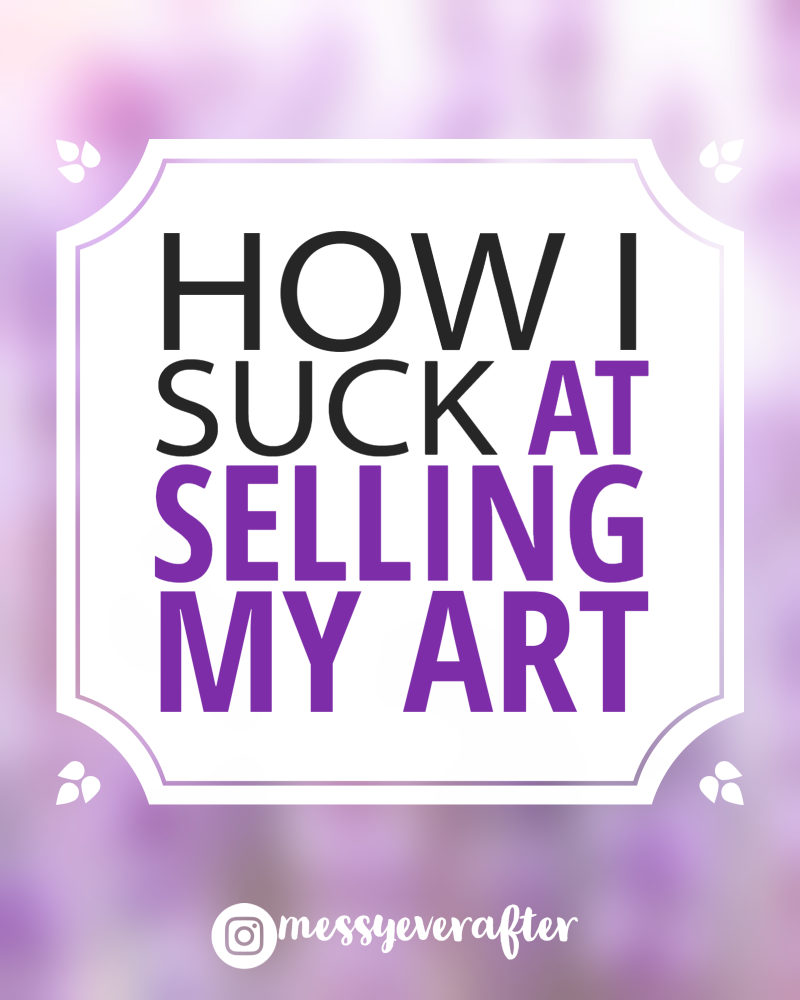Come with me as I try to be a full-time artist:
As the title of this post oh so delicately suggests, I am not the best at selling my art.
My default factory setting did not come with a “saleswoman” button. And unfortunately, money is not the biggest motivator for me to step out of my comfort zone. I’ve worked retail jobs where was paid commissions, but that did nothing to incentivize me to push hard for sales. In my head, I thought maybe these customers didn’t really need the product. Who am I to force this upon someone?

Obviously, this is an issue. If I plan on making a living as an artist, it would be beneficial to sell things. Clearly, I desire to make money–I would just like to be comfortable while doing it.
So, why am I so bad at selling my art and other creative products?
First, I am an introvert. Talking to people is exhausting if I don’t know them and don’t know what to talk to them about. It also opens the door for me to say and do awkward things, and then remember those interactions years later in painful detail.

Second, I make the false assumption that potential customers shop like I do. I don’t like being pressured to buy anything. I do research on products before I commit to a purchase. Everything from shampoo to a couch. Hasty decisions are rarely made. Thus, I do not push other people to buy from me.

Three, selling art is like selling a piece of yourself and it’s quite difficult for me to put a price on that.
It would be incredibly convenient for me if potential customers would say, “I value your art. Let me pay you ‘x’ amount.” And if ‘x’ amount is something I would be happy with, then we both walk away feeling satisfied with the transaction.

Instead, I am often times left teetering between what I think my art is worth, and what I think people might be comfortable paying for my work. I tend to short-change myself this way, but my goal is to unload my art, buy more supplies, and eat Chipotle. I’ve been so anxious to get rid of my art that I have basically given it away at times.

To challenge my comfort zone, I displayed my work at a local art event last week. Naturally, I wanted to make the event more successful so I decided to compensate for my lackluster sales skills by trying a few new tactics. Like:
1. Overcome my introversion.
Introverts often cannot handle large crowds of people with only surface-level interactions, but we can thrive on conversations that are more meaningful. A fellow creative person offered me the advice of “treat each transaction as a relationship.”
That is what I did.

I didn’t try to convince anyone to buy my stuff. I talked to people. I showed an interest in their experiences. I shared my techniques. I treated people as people and not as a potential sale.
Was this successful?
I had a tension headache by the end of the night and my cheeks hurt from smiling for 5 hours, but it worked.
2. Stop assuming people are like me.
I don’t meet a lot of people like me in public—so assuming people shop like me isn’t a great idea.
I decided to present myself more and do the exact opposite of how I want people to treat me. I engaged customers when they approached and put in the effort to approach them as well. I made sure to tell them I was the artist. Apparently, I don’t come off immediately as the creator.
Once I established my artistry, the conversations kept going, and sales happened more frequently. People want to know the artist.
Opening the dialogue and being forward with information allowed me to feel like I was creating an experience and not pushing for a sale. This even works on other fellow introverts. Just focus on making a connection meaningful.
3. Place a value on my art.
I priced most of my work a little higher than I was comfortable with, and then I tried something new at this event. I made a “Name Your Price” bin. I have a bunch of prints and work that I am tired of looking at. Instead of telling people what they are worth, I let them choose. To my surprise, people went for it.
Out of the majority of sales from the “Name Your Price” bin, customers paid at or above what I would have asked for.
I also settled with the fact that I will always price lower than I should, but I made it a point to clearly label all pieces with these outrageously low numbers. If you don’t put a visible price on your work, a lot of people won’t ask. They may just assume the piece isn’t for sale.
***
To my surprise, this was the most successful event that I have ever done, in both sales and pleasant interactions with people. The location of my display, the favorable weather conditions, and other factors definitely played into the traffic at this event, but my effort to come out of my bubble contributed to my success.
Maybe I don’t suck at selling my art as much as I think I do. Like any skill, I can get better at it.
-Kelly

